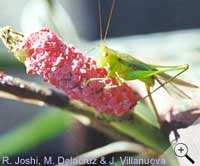Long-horned grasshoppers eat golden kuhol eggs
News release - October 29, 2001
|
Long-horned grasshoppers eat golden kuhol eggs News release - October 29, 2001 |
|
 Long-horned grasshoppers (Conocephalous longipennis) just love those round, pinkish eggs of golden kuhol. |
PhilRice researchers Ravindra C. Joshi, Mario S. de la Cruz, Antonio R. Martin, and Angelito V. Duca recently conducted two separate studies on the control of golden apple snails or golden kuhol. These studies involved validating farmers' practice of applying inorganic fertilizers basally and the long-horned grasshoppers feeding on the eggs of golden kuhol.
Use of inorganic fertilizers
The researchers found that basal incorporation of 60-40-40 NPK/ha, which is
based on the recommended rate, reduced golden kuhol population to a maximum
of 54%.
At PhilRice Maligaya station, the researchers simulated the farmers' practice
of incorporating inorganic fertilizers before final leveling. After one week,
they observed that golden kuhol floated on water, emitted an unpleasant
odor, and became inactive and immobile.
"The golden kuhol might have died because of visibly intensified mucus
secretion," the researchers said. They stressed that as the golden kuhol
became immobilized, these might have been also exposed to unfavorable conditions
such as sunlight.
Long-horned grasshoppers eat golden kuhol eggs
The long-horned grasshopper (Conocephalous longipennis de Haan),
locally known as tipaklong na mahaba ang sungot, can also reduce golden kuhol
population by feeding on its eggs.
The study started when the researchers encountered few golden kuhol eggmasses
that were either devoured or with crushed eggshells in the rice fields.
"On closer examination, we observed that such eggs were chewed upon, empty,
and with crushed eggshells," the researchers said.
To pinpoint the cause of the damage to the eggs, they sampled for possible predators
in rice and non-rice habitats. The rice stubbles, substrates along rice bunds,
and newly transplanted rice fields that harbored high density of golden kuhol
egg clusters served as sampling areas.
In the samples gathered, the researchers identified fire ants, non-web forming
spiders, long-horned grasshoppers, and earwigs as the possible predators.
A series of greenhouse trials narrowed down the predators of golden kuhol to
two, namely: long-horned grasshoppers and fire ants. However, the gut content
analysis of the grasshoppers collected from the field and greenhouse confirmed
the true predator.
"When the long-horned grasshoppers were dissected, we saw eggshell fragments
and red to pinkish macerated golden kuhol eggs before and after the gizzard
portion of the alimentary canal," the researchers noted.
The researchers also observed that golden kuhol eggmasses were consumed mostly
at night, suggesting that C. longipennis are night feeders. Their adults fed
more than their nymphs did, and they preferred two-day-old eggs to newly laid
eggs.
Earlier, some researchers had reported that long-horned grasshoppers could predate
on eggs of rice bugs and stem borers, as well as on the nymphs of planthoppers
and leafhoppers.
Hence, the researchers recommended that rice farmers should be informed on the
importance of conserving egg predators such as the long-horned grasshoppers.
To control golden kuhol, farmers often use the existing commercial molluscicides
such as niclosamide and metaldehyde.
However, aside from being hazardous to the health of farm workers, these pesticides
lasted for two to three days only. This implies that such mollucicides are no
longer effective in killing golden kuhol that emerge in the soil surface after
being inactive for several months, including those that would enter the treated
fields.
Ronan G. Zagado and Olive Rosa O. Matchoc